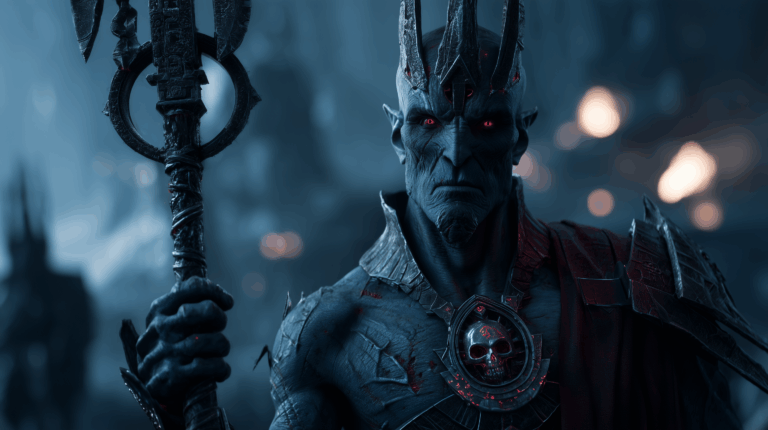Nergal

Nergal is the Mesopotamian god of death, pestilence, and plague, serving as the Lord of the Underworld. He embodies a specific aspect of death, often seen as inflicted death, and is also closely linked to warfare. Nergal’s role as a god of plague and pestilence aligns him with demonic forces, further emphasizing his warlike characteristics. As a war deity, he accompanies kings into battle, bringing death to enemies. His involvement with disease, often attributed to demonic causes in Mesopotamian beliefs, reflects his control over various malevolent entities, including the notorious ilū sebettu, or “Seven Gods,” known for their destructive capabilities, as depicted in the Erra Epic.
Nergal’s apotropaic qualities are connected to his chthonic nature. Protective figurines representing Nergal were used in rituals, and the Erra Epic was utilized as a house amulet to ward off evil. These practices highlight the god’s role not only as a bringer of death but also as a protector against supernatural dangers.
Initially known as Meslamtaea in the Early Dynastic Period, Nergal was worshiped primarily in Kutha, his main cult center. From the Old Babylonian Period onward, he was syncretized with Erra, a Semitic god of death. In historical and academic sources, Nergal is described as the son of Enlil, not Enki, as non-academic sources suggest. His consort appears at times as Mamma, Mammi, Mammitum, Ninshubur, Admu, and eventually Ereshkigal. The myth of Nergal and Ereshkigal details his descent to the underworld, where he initially escapes but is later compelled to return, ultimately co-ruling the netherworld with Ereshkigal. This narrative likely represents an attempt to reconcile different Mesopotamian traditions concerning the rule of the underworld.
The main cult center of Nergal was Kutha, but his worship extended to other cities, including Mashkan-Shapir, Dilbat, Isin, Larsa, Nippur, Ur, and Uruk. The earliest evidence of Nergal appears in god lists from Fara and Abu-Salabikh, where he is referred to as Meslamtaea. By the Ur III period, the name Nergal becomes more prominent, and by the second millennium, he is recognized as a co-ruler of the underworld alongside Ereshkigal. In the Neo-Assyrian period, Nergal was significant in the official Assyrian cult.
Nergal is iconographically depicted as a male figure holding a scimitar or mace, often adorned with a double lion’s head. He is also associated with the bull, symbolizing his aggressive and formidable nature.
The god’s dual role as both a bringer of death and a protector against supernatural forces underscores his complex character. As a deity of both warfare and the underworld, Nergal remains a significant figure in Mesopotamian mythology, symbolizing the destructive yet protective powers of death.
Nergal is portrayed in the Anunnaki tradition as a son of Enki, making him a brother or half-brother to Marduk, Ningishzidda, and Dumuzi. His consort is Ereshkigal, the powerful goddess of the underworld, which places Nergal in a key position as a ruler of the netherworld.
While not one of the leading figures in the earliest operations of the Anunnaki on Earth, Nergal rises in importance during later epochs. He is entrusted with missions of enforcement and judgment, and according to the narrative, he becomes the Anunnaki lord of the Lower World, sharing dominion over the underworld with his consort. This role gives Nergal authority over death, disease, and destruction, and he is often depicted as a god of plague and war, feared for his power to unleash devastation.
According to Sitchin’s interpretation, Nergal was also involved in a critical mission to the spaceport in the Sinai Peninsula, a location known as the “Place of the Celestial Chariots.” He and his companion Ninurta, representing the Enlilite faction, are sent to destroy the spaceport to prevent its use by the rebellious Marduk. This military action results in a nuclear-like devastation, which Sitchin links to the destruction described in later Biblical events such as the fall of Sodom and Gomorrah. Nergal’s role in this catastrophe positions him as a harbinger of cataclysmic change, enforcing divine decrees with terrifying consequences.
Despite his fearsome image, Nergal’s rulership over the underworld is not simply punitive. His presence in the netherworld balances the cosmic order, ensuring that the souls of the dead are judged and maintained under divine jurisdiction. His union with Ereshkigal also symbolizes a fusion of Enki’s line with the deep mysteries of the underworld, tying Nergal’s role to cycles of death, renewal, and divine justice.
In the larger framework of the Anunnaki hierarchy, Nergal stands as an enforcer, a divine executor of verdicts, and a powerful reminder that no one, not even among the gods, escapes consequence. His presence in the mythos embodies cosmic law, retribution, and the dark power that lies beneath creation.